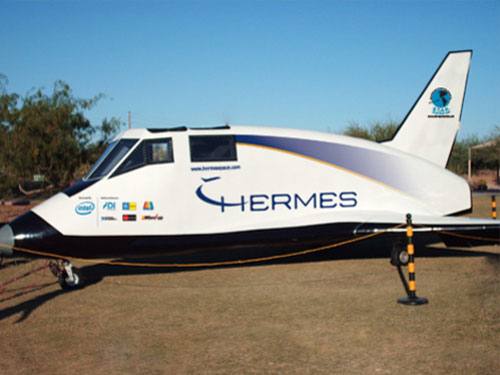'Shuttle for Everyone' Prototype on Display at Intel Developer ForumLike many Americans coming of age during the time of the Apollo missions, Morris Jarvis dreamed of someday blasting off into space. As a child he sat glued to the television set as man walked on the moon, and he later studied aerospace engineering in college. Over the years Jarvis built countless models of spaceships, exhaustively studied the space shuttle program and even interviewed real astronauts and NASA engineers. But even his friends and co-workers were a little surprised when in 1993 he stopped dreaming and started building a space shuttle in his garage in suburban Phoenix.
Jarvis founded Star Systems Inc. and began working evenings, weekends and vacations, even recruiting some of his engineering colleagues in his quest. The result is a prototype of his Hermes Spacecraft, which is on public display for the first time at the Intel Developer Forum.
Morris and his team are building Hermes out of their own pockets and figure they need about $1.5 million to finish the test work and begin regular space flights. The team is undertaking a grassroots fundraising effort to secure the remaining dollars as well as recruiting other "dreamers" for their mission.
"There isn't a geek out there who hasn't dreamed of being an astronaut," says Jarvis. "We're all dreamers."
Hermes, named for the mythological Greek God of boundaries and the travelers who cross them, is a technological marvel loaded with some of Intel's most advanced embedded chips including the Intel(R) EP80579 Integrated Processor SOC product line and the Intel(R) Atom(TM) processor Z5xx series. Intel technology powers most of the spacecraft's data gathering, test and communications systems. Other companies assisting the Hermes team include ADI Engineering, Dot Hill, GE Fanuc, MicroSun, and National Instruments.
Hermes' first flight will be an unmanned, tethered flight at Utah's Bonneville Salt Flats in October during which Morris will control the spacecraft from a remote cockpit on the ground. Numerous sensors and computing systems will gather critical flight data and provide real-time feedback to Morris and his flight crew. Once the tethered flights are completed, Hermes will be equipped with an engine pod so it can be flown like an airplane, unattached to the ground. In the future, Hermes will be towed to about 113,000 feet above the earth by an ultra-high altitude helium balloon, then flown back to earth using the remote cockpit. Finally, another test will be undertaken with an onboard pilot. If all goes well, Morris and his colleagues plan to build a production version of Hermes and begin offering regular space flights.
"Hermes is built on the premise that anyone who wants to should be able to take a trip into space," says Jarvis. "We hope to provide trips for about the price of a new car."
About The Hermes Spacecraft
The Hermes Spacecraft is a commercial venture designed to provide affordable space travel to enthusiasts and adventure travelers. The company was founded by engineer and space "dreamer" Morris Jarvis in his garage in Phoenix, Arizona. The Hermes prototype is scheduled for its first test flight in the fall of 2008.












